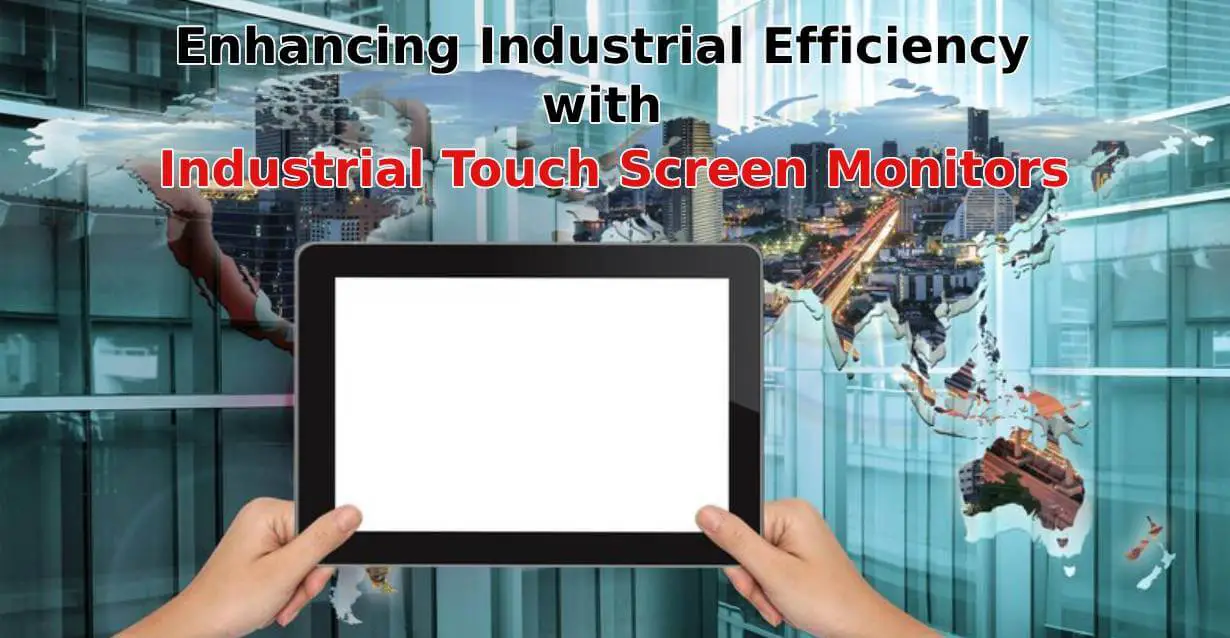Enhancing Industrial Efficiency with Industrial Touch Screen Monitors:

In today’s fast-paced industrial landscape, efficiency and productivity reign supreme. Industrial Touch Screen Monitors have emerged as indispensable tools, streamlining operations and empowering workers with intuitive interfaces.
From manufacturing floors to control rooms, these cutting-edge devices offer a seamless blend of durability, functionality, and versatility. Let’s delve into the world of Industrial Touch Screen Monitors, exploring their myriad applications and transformative potential.
Understanding Industrial Touch Screen Monitors
Industrial Touch Screen Monitors, also known as HMI (Human-Machine Interface) displays, are specialized computing devices designed for rugged industrial environments.
They integrate touch-sensitive screens with robust hardware, enabling users to interact with machines, systems, and processes effortlessly.
Exploring Industrial Touch Screen Monitor Technology
Industrial Touch Screen Monitors employ various technologies, including resistive, capacitive, and surface acoustic wave (SAW). These technologies differ in their responsiveness, durability, and suitability for different environments.
Advantages of Industrial Touch Screen Monitors
Enhanced Usability:
Industrial Touch Screen Monitors offer intuitive interfaces, reducing the learning curve for operators.
Durability:
Built to withstand harsh industrial conditions, these monitors are resistant to dust, moisture, and temperature extremes.
Space Efficiency:
By eliminating the need for physical keyboards and mice, Industrial Touch Screen Monitors optimize workspace utilization.
Real-Time Data Visualization:
With dynamic graphical displays, operators can monitor processes and performance metrics in real time, facilitating informed decision-making.
Applications of Industrial Touch Screen Monitors
Manufacturing:
From assembly lines to CNC machines, Industrial Touch Screen Monitors streamline production processes, improving efficiency and quality control.
Automation:
In automated systems, these monitors serve as the primary interface for programming, monitoring, and troubleshooting.
Control Rooms:
Industrial Touch Screen Monitors provide operators in control rooms with comprehensive visualization of critical systems and processes, enabling swift response to deviations or emergencies.
Logistics and Warehousing:
In logistics and warehousing operations, these monitors facilitate inventory management, order fulfilment, and logistics tracking.
Best Practices for Deploying Industrial Touch Screen Monitors
- Conduct thorough environmental assessments to ensure compatibility with operating conditions.
- Choose the appropriate touch screen technology based on usage requirements and environmental factors.
- Implement robust cybersecurity measures to safeguard sensitive data and prevent unauthorized access.
- Provide comprehensive training to operators to maximize efficiency and minimize errors.
- Regularly calibrate and maintain Industrial Touch Screen Monitors to ensure optimal performance and longevity.
Industrial Touch Screen Monitors: Driving Operational Excellence
Industrial Touch Screen Monitors are more than just displays; they are catalysts for operational excellence, empowering organizations to achieve higher levels of efficiency, productivity, and competitiveness.
With their intuitive interfaces, rugged design, and versatile applications, these devices are indispensable assets in the modern industrial landscape.
Harnessing the Power of Industrial Touch Screen Monitors
Enhanced Efficiency:
By simplifying user interactions and providing real-time feedback, Industrial Touch Screen Monitors accelerate workflows and minimize downtime.
Improved Safety:
Intuitive interfaces and visual cues help operators navigate complex systems safely, reducing the risk of accidents and injuries.
Optimized Resource Utilization:
With access to real-time data and analytics, organizations can optimize resource allocation and minimize waste.
Facilitated Decision-Making:
Industrial Touch Screen Monitors empower stakeholders with actionable insights, enabling data-driven decision-making at all levels of the organization.
Conclusion
In conclusion, Industrial Touch Screen Monitors represent a paradigm shift in industrial automation and control. With their robust design, intuitive interfaces, and versatile applications, these devices empower organizations to unlock new levels of efficiency, productivity, and safety.
By harnessing the power of Industrial Touch Screen Monitors, businesses can stay ahead of the curve in today’s competitive marketplace.
